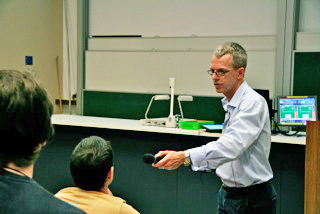
First-year physics students at The University of Queensland are understanding their lectures two and a half times more than in traditional classes, with the implementation of a new active learning strategy.
Professor Michael Drinkwater from the UQ School of Mathematics and Physics said that the new active learning strategy has enabled lecturers to reach more students, thereby broadening the appeal and understanding of physics.
“We developed this strategy because we wanted to base our teaching methods on research and data, not opinion,” Professor Drinkwater said.
“We want to reach first-year students who don’t understand physics or don’t normally cope, possibly due to past negative experiences.”
In the new active learning strategy, students engage in preparatory reading and answer short online quizzes before their lectures.
In a key innovation, the lecturers then move on to use a purpose-built computer software tool to mark the quizzes rapidly, identifying common difficulties faced by the students and select certain responses for students to discuss in groups during lectures.
“Normally a lecturer isn’t aware of what a student doesn’t understand or if there are any misconceptions that need to be clarified, until after the final exam,” Professor Drinkwater said.
“With this teaching method, misunderstandings or problems are addressed during the lecture, when students discuss complex concepts in groups.”
As a result, the lecturer’s role in the new active learning strategy shifts from the traditional heavy-content lecturing to focused-discussions on core concepts that have been identified as areas that students find difficult.
Professor Drinkwater said that he no longer needs to stand at the front of the lecture theatre and convey a lengthy lecture to students.
Instead, he now he walks around the lecture theatre, listening and getting involved in the discussions, and observing the notes that the students are writing down.
“Implementing active learning strategies in large classes of over 400 students presents many challenges, but we have shown that it can be done and it is working well,” Professor Drinkwater said.
“I could never go back to the traditional way of lecturing as I enjoy being able to interact more with the students,” he said.
The successful active learning strategy is now being used in all first-year physics courses in UQ, and is currently being implemented into its second and third-year physics courses, with a potential to be used in other science courses in the university in future.
Additionally, the new strategy has been introduced in a first-year engineering course at UQ.
The study on the research and development of this new active learning strategy was published this month in Teaching and Learning Inquiry, and was led by Professor Drinkwater.
Other authors of the study are Ms Deanne Gannaway, Ms Karen Sheppard, Professor Matthew Davis, Dr Margaret Wegener, Associate Professor Warwick Bowen, and Dr Joel Corney -- also from UQ.
The research paper can be viewed on the JSTOR website.
For more information, contact Professor Michael Drinkwater (07 3365 3428, m.drinkwater @uq.edu.au)



